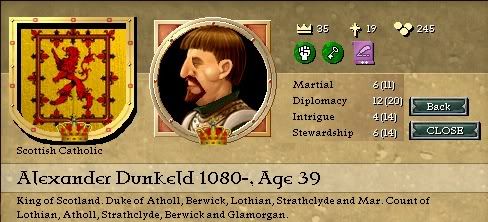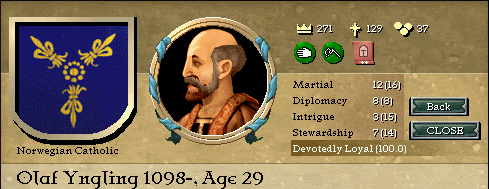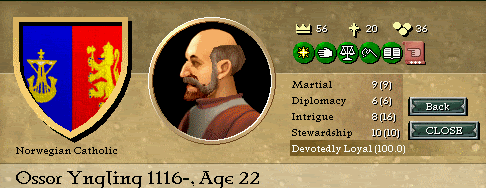Country: Norway
Version: 1.04a (These instant reunifications that’s happening in the beta doesn’t fit my plans for this game. Crusades won’t be a major part anyway.)
Scenario: Vanilla 1066. I’ve changed the inheritance laws to semisalic gavelkind, and gave Magnus Haraldsson Intestinal worms to make him die earlier.
Difficulty: Normal/Normal (I’m not a good player)
Rules & cheats: When Norway enters her period of civil war, I will probably edit loyalty down to make sure brothers don’t stay on friendly terms too long. I will frequently “die” Scandinavian rulers who loose important battles in person. There will be no crusading in Finland and the Baltic, at least until I conquer Sweden.
1. When King Harald Sigurdsson died, his sons Magnus and Olaf became kings in Norway. They split the land between them, Magnus ruling the north and Olaf the south. But in their fifth year as kings, Magnus fell ill and died. At Øreting, his son Svein Magnusson was made king, but he was yet not one winter old. He was brought up by the best men in Trondheim.
2. The people of Jemtland had ceased paying their taxes some years ago. King Olaf sent men to them to remind them who was king. The Jemtes first thought to make resistance, but when they saw how numerous the king’s host was, most of them gave up and swore loyalty to King Olaf. Those that resisted either were either killed or had to flee the country losing all their land and property.
3. King Olaf took great interest in farming and trading. He sent men southwards to Europe to learn how things were done there. He also set up many new trading places and made laws for how people should behave when doing business. Unlike his father, Olaf was rather quiet and unwarlike. The wars he fought, was forced upon him, but in battle he none the less fought with an almost reckless bravery.
4. Olaf married Ingrid, daughter of King Svein Ulfsson of Denmark. They had three sons, Åmund, Harald and Erling. Both Åmund and Erling were sickly however, and both died while still youths. There were peace and friendship between King Olaf and King Svein, and both swore that there should be no war between their countries while they still lived.
5. King Svein Magnusson died twenty-one years old. He was often sick as a child, and his health did not get better as he grew up. He fell ill around Christmas and died before Easter. When King Olaf heard that Svein was dead, he travelled to Trondheim, and was hailed as king on Øreting by the Trønders.
6. Eirik Steinkjellsson was king in Sweden in these days. His mind became stranger than that of most men’s as he grew old. He made his brother marry a horse and forbid his men to drink beer and other things the Swedes talk about to this day. When Olaf had been king for thirty years, king Eirik suddenly announced that he would go to Norway and take back what his forefathers had lost. His men did as he bid, thinking that this was just one of his mad ideas; they expected to get a good laugh out of the whole thing. King Eirik however, proved to be quite serious. He led his men into Ranrike. When King Eirik’s men saw that the land lay undefended, they forgot their earlier misgivings, and begun burning and plundering.
7. Harald Olafsson had been given the defence of Viken by his father, and was staying at Kongehelle when he heard about King Eirik. Seeing that the Swedes had many more men than him, he at once sailed to his father at Oslo. King Olaf set out with all the men he could gather. He followed after the Swedish army which had gone back to Gautland. King Olaf met king Eirik in battle at the shores of Väneren. There fell King Eirik along with most his men.
8. The Swedes now chose Gustav of Munsö to be their new king, claiming that the blood of Steinkjell was tainted by madness. While Gustav gathered together a new army, King Olaf took Värmland which had been under Norway in the old times. He was also joined by Knud Sveinsson of Sola who had brought with him the men of Trondheim and West-Norway. Thus when King Gustav arrived, Olaf had the greater army and Gustav was defeated. King Gustav was forced to agree to peace on the condition at all land west of Väneren should remain in Norway.
9. When King Olaf was fifty-eighth, he became seriously ill and died shortly afterwards. He had then been king for forty-one years, more than anyone before him.
Gallery

King Olaf Haraldsson

King Magnus Haraldsson

King Svein Magnusson

Harald Olafsson

King Eirik Steinkjellsson
Short timeline
1066: Death of Harald Hardråde at Stamford Bridge. Magnus and Olaf become kings.
1071: Magnus Haraldsson dies. Harald Olafsson is born.
1092: Svein Magnusson dies.
1097: War with Sweden.
1108: Death of Olaf Haraldsson.
Version: 1.04a (These instant reunifications that’s happening in the beta doesn’t fit my plans for this game. Crusades won’t be a major part anyway.)
Scenario: Vanilla 1066. I’ve changed the inheritance laws to semisalic gavelkind, and gave Magnus Haraldsson Intestinal worms to make him die earlier.
Difficulty: Normal/Normal (I’m not a good player)
Rules & cheats: When Norway enters her period of civil war, I will probably edit loyalty down to make sure brothers don’t stay on friendly terms too long. I will frequently “die” Scandinavian rulers who loose important battles in person. There will be no crusading in Finland and the Baltic, at least until I conquer Sweden.
Olaf Haraldsson’s saga
1. When King Harald Sigurdsson died, his sons Magnus and Olaf became kings in Norway. They split the land between them, Magnus ruling the north and Olaf the south. But in their fifth year as kings, Magnus fell ill and died. At Øreting, his son Svein Magnusson was made king, but he was yet not one winter old. He was brought up by the best men in Trondheim.
2. The people of Jemtland had ceased paying their taxes some years ago. King Olaf sent men to them to remind them who was king. The Jemtes first thought to make resistance, but when they saw how numerous the king’s host was, most of them gave up and swore loyalty to King Olaf. Those that resisted either were either killed or had to flee the country losing all their land and property.
3. King Olaf took great interest in farming and trading. He sent men southwards to Europe to learn how things were done there. He also set up many new trading places and made laws for how people should behave when doing business. Unlike his father, Olaf was rather quiet and unwarlike. The wars he fought, was forced upon him, but in battle he none the less fought with an almost reckless bravery.
4. Olaf married Ingrid, daughter of King Svein Ulfsson of Denmark. They had three sons, Åmund, Harald and Erling. Both Åmund and Erling were sickly however, and both died while still youths. There were peace and friendship between King Olaf and King Svein, and both swore that there should be no war between their countries while they still lived.
5. King Svein Magnusson died twenty-one years old. He was often sick as a child, and his health did not get better as he grew up. He fell ill around Christmas and died before Easter. When King Olaf heard that Svein was dead, he travelled to Trondheim, and was hailed as king on Øreting by the Trønders.
6. Eirik Steinkjellsson was king in Sweden in these days. His mind became stranger than that of most men’s as he grew old. He made his brother marry a horse and forbid his men to drink beer and other things the Swedes talk about to this day. When Olaf had been king for thirty years, king Eirik suddenly announced that he would go to Norway and take back what his forefathers had lost. His men did as he bid, thinking that this was just one of his mad ideas; they expected to get a good laugh out of the whole thing. King Eirik however, proved to be quite serious. He led his men into Ranrike. When King Eirik’s men saw that the land lay undefended, they forgot their earlier misgivings, and begun burning and plundering.
7. Harald Olafsson had been given the defence of Viken by his father, and was staying at Kongehelle when he heard about King Eirik. Seeing that the Swedes had many more men than him, he at once sailed to his father at Oslo. King Olaf set out with all the men he could gather. He followed after the Swedish army which had gone back to Gautland. King Olaf met king Eirik in battle at the shores of Väneren. There fell King Eirik along with most his men.
8. The Swedes now chose Gustav of Munsö to be their new king, claiming that the blood of Steinkjell was tainted by madness. While Gustav gathered together a new army, King Olaf took Värmland which had been under Norway in the old times. He was also joined by Knud Sveinsson of Sola who had brought with him the men of Trondheim and West-Norway. Thus when King Gustav arrived, Olaf had the greater army and Gustav was defeated. King Gustav was forced to agree to peace on the condition at all land west of Väneren should remain in Norway.
9. When King Olaf was fifty-eighth, he became seriously ill and died shortly afterwards. He had then been king for forty-one years, more than anyone before him.
Gallery

King Olaf Haraldsson

King Magnus Haraldsson

King Svein Magnusson

Harald Olafsson

King Eirik Steinkjellsson
Short timeline
1066: Death of Harald Hardråde at Stamford Bridge. Magnus and Olaf become kings.
1071: Magnus Haraldsson dies. Harald Olafsson is born.
1092: Svein Magnusson dies.
1097: War with Sweden.
1108: Death of Olaf Haraldsson.








